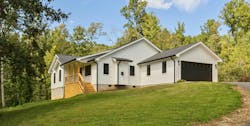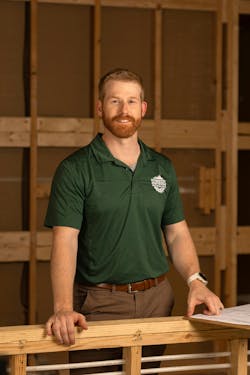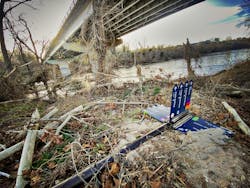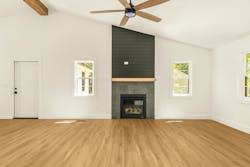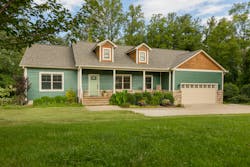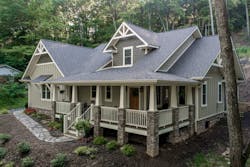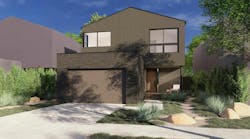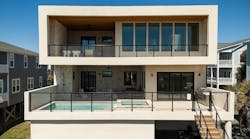Rebuilding Western North Carolina: A Builder’s Turn to Restoration After Hurricane Helene
Story at a Glance:
- Scroggs Construction pivoted to disaster recovery after Hurricane Helene, converting their basement into a supply warehouse and coordinating donations for affected communities.
- Realizing a need, the company added a restoration division, completing its first project in just seven months.
- Other projects proved more challenging because of strict local codes, insurance limitations, and labor shortages.
- The company learned valuable lessons in project pacing, staff training, and resource scheduling.
Jerry and Kelly Owensby’s ranch home in Fairview, N.C., was one of nearly 20,000 damaged or destroyed when Hurricane Helene tore through Western North Carolina on Sept. 27, 2024. A massive oak, nearly six feet in diameter, had toppled into their bedrooms. Another tree had crushed the garage. And the home itself was twisted off its foundation.
But, one year later, they’re living in it again.
The builder who made that happen, Nick Scroggs of Asheville, N.C.-based Scroggs Construction Services, has since taken on more than 40 disaster recovery projects across the region, a pivot that required expanding his custom home and remodeling business to incorporate a restoration division.
Builder/Remodeler to First Responder
In the immediate aftermath of Helene, Scroggs and his team stopped all regular projects for four to six weeks. Staff couldn’t reach the office due to downed trees and destroyed bridges, and the company’s own building had taken on silt and water damage.
"We spent a few weeks just trying to clean up the building and get it ready to be livable again and also traveling around trying to help cut down trees to get people out of their houses," Scroggs recalls.
As recovery efforts organized, Scroggs Construction converted its basement into a supply warehouse, coordinating donation intake and deliveries to community distribution sites.
Different locations were specializing in different supplies—diapers and baby items at a church in one county, personal protective supplies in another—and Scroggs' team worked to route donations efficiently.
"People wanted to help, and they didn't know how," Scroggs say. "They were sending whatever they could, and we would figure out where it went and get it out."
But as the weeks progressed, Scroggs recognized the next step was to help rebuild the community.
Building a Restoration Division
“The scope of the work that we do is already very similar to restoration work,” he says.
Because he already had in-house design, production, and construction staff (unusual in a market where many builders rely entirely on subcontractors) he was able to add on a new restoration division and integrate it into the systems he already had in place.
Scroggs, who also serves as president of the local home builders’ association, the Builders Association of the Blue Ridge Mountains, tapped his network to get the word out about the restoration services.
“I’m fortunate that our company has been around long enough and I’ve been in the network long enough that a lot of people know us,” he says.
But it was serendipity that made the Owensby project one of the first they took on. Scrogg’s sales and marketing director Jack Sorrentino was a neighbor of the Owensbys and had spent days clearing debris in many homes in the area, helping to remove tree limbs and debris and tarping the roof of the Owensby home, too.
But once neighbors were safe and the streets were passable, he reached back out to see if he might help with the restoration process now as well.
“I could sense the feeling of helplessness they were experiencing,” Sorrentino says. “My heart sank when I saw their house.”
It had been deemed a total loss. But since the home had only been built 20 years prior, the Scroggs team was able to take the initial sketches of the house and redo an entire construction set using the existing foundation.
“They loved their house, and didn’t want to be displaced,” says Scroggs. “So, we were able to tear everything down except the foundation. It was going to be reusable, and that ended up saving them a lot of money.”
Thoughtful Updates
The homeowners mostly wanted to recreate the existing space, so the Scroggs team helped them make some adjustments to the drawings—adding in a vaulted ceiling, expanding the porch, and opening up the kitchen and dining space—but then worked to salvage and save what they could, like the kitchen cabinets, plumbing fixtures, and electrical fixtures, to not only save money but to provide a connection to what was there prior, a meaningful gesture after so much loss.
For Scroggs, the Owensby rebuild worked out as 'something of a miracle.'
The insurance company was quick to classify the home as a total loss, so there were no partial-claim disputes or separate approvals to slow things down. “When they throw up their hands and say, ‘tear it down and rebuild it,’ it actually makes it easier,” Scroggs says. “There’s nothing to supplement, no drawn-out debates over code upgrades. You just start fresh.”
And the timeline was remarkable, too, he says. The hurricane hit in late September; demolition began by early spring and was completed within seven months.
Partial Restoration Problems
But not every recovery job has gone so smoothly.
While a full teardown like the Owensbys’ had quick insurance approvals and simplified permitting, other projects have proved far more complicated. “The hardest projects have been the ones where a tree took out half the house and we’re trying to restore what’s left,” Scroggs says.
In those cases, the challenge became navigating local code requirements along with the complications of insurance coverage. Many municipalities now require full code compliance if repair costs exceed a set percentage of the home’s appraised value, Scroggs says. “That sounds great until you realize insurance rarely covers those code upgrades,” he explains. “So, homeowners end up thousands short before work can even begin.”
The part of the community that needs the help most is the part getting hit hardest by the rules meant to protect them.
- Nick Scroggs, Scroggs Construction Services
Early projects like the Owensbys’ moved faster, he says, because urgency was prioritized over red tape. But as the months passed and agencies caught up, reviews grew stricter, and approvals slowed. The result was that the people without quick insurance or enough savings to front the cost of repairs while they waited for settlements have been left waiting longest to restore their homes.
“It’s tough,” Scroggs says. “The part of the community that needs the help most is the part getting hit hardest by the rules meant to protect them.”
Materials and Labor Shortages
One silver lining was that, despite the scale of regional damage, there were relatively few material shortages. Lumber and specialty trusses were briefly backlogged, Scroggs says, but national supply chains held steady.
The greater challenge, he says, was labor. Western North Carolina’s pool of skilled trades was already thin before the storm, and many subcontractors, who were facing their own losses or weeks without pay, simply left for jobs in larger markets. “The people doing the work were the same ones most affected,” he says. “They had to find work fast, and some didn’t come back.”
Lessons Learned
Scroggs says the experience has reshaped the way his firm approaches projects. Settling on a good pace—scaling back from an “unreasonable” 10 to 12 new jobs to a more manageable pace of six—has kept the pipeline moving without burning out the team.
Onboarding employees juggling their own restoration projects proved a bit more challenging. Scroggs learned that it was critical to train them more quickly on internal systems with the high volume of jobs coming in.
“We made errors,” Scroggs says, “but the team learned fast, and they cared deeply about the community. That mattered more than anything.”
The chaos also reshaped how Scroggs thinks about coordination. “We learned to be more intentional about scheduling shared resources,” he says. “You can’t throw every crew at every fire and expect it to go smoothly. That discipline is something we’ll keep long after the recovery ends.”
Restoration work also tested Scroggs’ definition of quality. “We’re meticulous by nature,” he says. “But when insurance only pays to put things back exactly as they were, you can’t fix every flaw. That’s been hard for us, but it reminds us why our quality checks exist—to make sure that even in a rebuild, we’re delivering something better than standard.”
I have seen several people put themselves out of business trying to help their community. You're not serving others if you're out of business.
- Nick Scroggs, Scroggs Construction Services
Advice to Other Builders
As president of the local builders association, Scroggs now urges others to prepare well before disaster hits and to make sure they truly understand the realities of disaster recovery.
“I know it seems kind of backwards to say, that you need to think about yourself when you’re making these decisions about how to service others,” he says. “But I have seen several people put themselves out of business trying to help their community. You're not serving others if you're out of business.”
Scroggs models that advice in practice. By working hard, staying disciplined, and keeping his business strong, he has ensured that his company, and all of his team members, could continue helping the community and restoring homes.
Nowhere was that more evident than at the Owensbys’ home. When they moved back in—eleven months to the day after Helene—Scroggs hosted a small ribbon-cutting ceremony to celebrate, inviting his entire team. “It was good for morale,” he says. “After months of getting yelled at by frustrated homeowners and dealing with delays, that moment reminded everyone why we do this.”
Related Reads
About the Author
Pauline Hammerbeck
Pauline Hammerbeck is the editor of Custom Builder, the leading business media brand for custom builders and their architectural and design partners. She also serves as a senior editor for Pro Builder, where she directs products coverage and the brand's MVP Product Awards. With experience across the built environment - in architecture, real estate, retail, and design - Pauline brings a broad perspective to her work. Reach her at [email protected].
